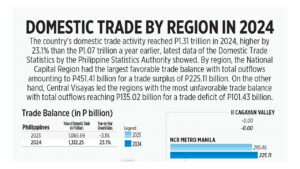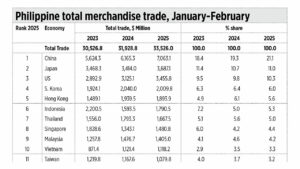Gov’t told to locate Filipinos in Myanmar, Thailand after deadly quake

By Adrian H. Halili, Reporter
PHILIPPINE SENATORS on Monday urged the government to strengthen efforts to locate and provide aid to Filipinos in Myanmar and Thailand after last week’s deadly earthquake.
In a statement, Senate President Francis G. Escudero called on Philippine Embassies in Myanmar and Thailand to account for all Filipinos and ensure that “all possible help is extended to them.”
“We still have Filipinos unaccounted for up to now and as such we should exert greater efforts to locate them at the soonest possible time,” Mr. Escudero added.
“Once the dust has settled and the rescue operations have concluded, we must have a full accounting of the Filipinos who may have been affected by the earthquake and extend every possible assistance as necessary, including psychosocial support for the survivors,” he said.
A 7.7-magnitude quake struck Myanmar and parts of Thailand last Friday, crippling major infrastructures like airports, bridges and highways. The recent quake is considered to be one of the biggest in the last century.
Reuters reported Myanmar’s state media has confirmed at least 1,700 deaths, while Thailand’s official death toll stood at 18, as of Sunday.
In a separate statement, Senator Sherwin T. Gatchalian likewise called on the Department of Foreign Affairs (DFA) and the Philippine Consulate in Myanmar to intensify their efforts to locate missing Filipinos.
Mr. Gatchalian added that the DFA in Thailand should “mobilize all resources to assist those who have been adversely affected and ensure that those in need of assistance are attended to.”
Asked to comment, DFA spokesperson Ma. Teresita C. Daza said that the Philippine Embassy in Yangon continues its efforts to account for all Filipinos in the earthquake affected areas.
“Yangon [Philippine Embassy] Advance Team is traveling to Mandalay to conduct on-the-ground assessment; check on the welfare of Filipinos; gather information on the four unaccounted Filipinos; and provide some basic supplies,” Ms. Daza said in a WhatsApp message.
Meanwhile, the Senate chief also called on the proper inspection of public and private infrastructure to ensure proper preparedness for large earthquakes.
“We must see to it that regular inspections are conducted on public infrastructure and on the structures constructed by the private sector, particularly the office and residential buildings that have sprouted over the past decades,” Mr. Escudero said.
The country’s National Capital Region sits on the West Valley Fault line which is said to be due for a major earthquake. The fault line traverses the cities of Taguig, Muntinlupa, Parañaque, Quezon City, Pasig, Makati, and Marikina, as well as the provinces of Rizal, Laguna, Cavite and Bulacan.
A potential 7.2 magnitude earthquake on the West Valley Fault, or “The Big One,” could result in an estimated 48,000 fatalities and $48 billion in economic losses, according to the World Bank.
Senate Minority Leader Aquilino L. Pimentel III called on the government to boost their disaster preparedness, following the Myanmar quake and the collapse of a bridge in Isabela province.
“The recent Myanmar earthquake and the collapse of the Isabela bridge are wake-up calls to reassess the country’s disaster preparedness and infrastructure resilience,” he said in a statement.
The P1.2-billion Cabagan-Santa Maria bridge in Isabela province collapsed on Feb. 27, due to alleged critical design flaws. The bridge ultimately collapsed under the weight of two overloaded trucks, each exceeding 100 tons and far beyond the bridge’s 44-ton capacity limit.
Mr. Pimentel added that the collapse of the bridge should have prompted an evaluation of ongoing construction projects to “ensure that each infrastructure can withstand an earthquake with intensity seven and above.”
The Philippines lies in the so-called Pacific Ring of Fire, a belt of volcanoes around the Pacific Ocean where most of the world’s earthquakes strike. It also lies along the typhoon belt in the Pacific and experiences about 20 storms each year.
The Philippines frequently experiences moderate to large earthquakes, according to the US Geological Survey.




